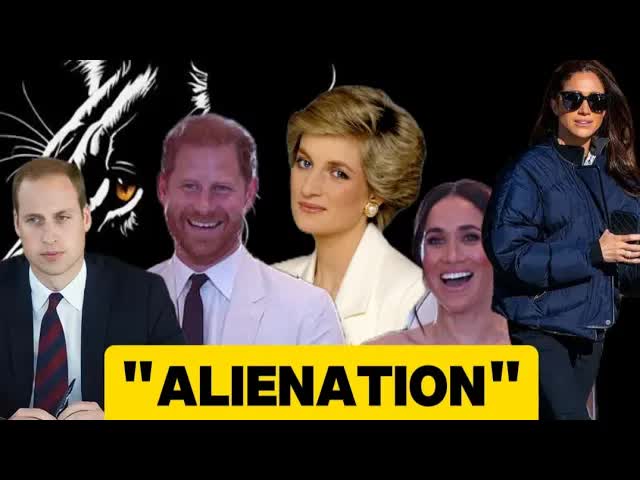Meghan Markle’s journey through royal life has been anything but smooth.
The Duchess of Sussex has faced a whirlwind of challenges that echo the experiences of her late mother-in-law, Princess Diana.
Both women have been thrust into the harsh spotlight of media scrutiny, leading to intense public criticism and personal turmoil.
As Meghan navigates her own path, her decisions resonate with the historical struggles of the monarchy, sparking vital discussions about its future.
The similarities between Meghan and Diana’s experiences are striking.
Both women endured relentless media attention, often characterized by invasive tactics that sought to undermine their dignity.
For Diana, whispers and rumors were skillfully leaked to the press, creating an environment of paranoia and isolation.
This constant barrage took a significant toll on her mental health, leaving lasting scars that would ultimately contribute to her tragic fate.
Fast forward to today, and it seems history is repeating itself.
Prince William, who once stood as a protector of his mother, now finds himself in a position that raises eyebrows.
His actions—or lack thereof—towards Meghan have led many to question whether the lessons learned from Diana’s struggles have truly resonated within the royal family.
The irony is palpable; the very system that caused Diana pain appears to be perpetuated by those who witnessed her suffering.
This disconnection is particularly painful for Prince Harry, who has seen firsthand the damaging effects of such treatment.
The ongoing tensions within the family threaten to expose old wounds, complicating relationships and eroding public trust in the monarchy.
William’s silence, once viewed as a dignified stance, now feels like complicity, further alienating the royal family from the very people they are meant to serve.
Media narratives play a significant role in shaping public perception of the royals, and both Diana and Meghan have been victims of this relentless scrutiny.
The tabloids have a notorious reputation for sensationalizing stories, often leading to harmful stereotypes and misinformation.
For Diana, the constant pursuit by paparazzi created a sense of danger and instability.
Similarly, Meghan has faced a barrage of negative press, much of which has been tinged with racist and sexist undertones, impacting her mental well-being.
The rift between Meghan and the royal family is not just a personal issue; it has broader implications for the institution itself.
Internal conflicts weaken the monarchy’s authority and legitimacy, creating a public image of a family disconnected from contemporary values.
As grievances are aired publicly, the royal family’s reputation continues to suffer, reinforcing perceptions of an outdated institution struggling to keep pace with modern life.
Traditionally, the royal family has maintained a policy of silence, adhering to a “never complain, never explain” mantra.
However, this approach is increasingly seen as ineffective.
In a world that demands transparency and accountability, the lack of communication from the palace has allowed speculation to thrive.
This failure to support members like Diana and Meghan highlights a systemic issue within the monarchy, one that jeopardizes its ability to adapt and evolve.
Both Meghan and Diana have found empowerment in sharing their truths, challenging the monarchy’s long-held narratives.
Diana’s candid interviews shattered the facade of royal life, while Meghan’s openness has resonated with many, highlighting the evolving role of women within this storied institution.
Their willingness to speak out demonstrates resilience, but it also underscores the urgent need for change within the royal family.
The repeated mismanagement of internal conflicts involving women who marry into the family raises serious questions about the monarchy’s modernity.
The disconnect between the royal family’s public image and their actions creates a dissonance that undermines public trust.
This gap is not just a domestic concern; it extends globally, affecting the monarchy’s brand and its influence on the world stage.
As the royal family faces this critical juncture, the choice is clear: adapt to the changing times or risk becoming irrelevant.
Embracing modernity means reflecting the values of the society they serve, promoting inclusivity, and engaging with the public in meaningful ways.
By prioritizing transparency and authenticity, the monarchy can begin to repair its tarnished image and restore its legacy.
Moving forward, healing and reconciliation are essential for the royal family.
The wounds of the past run deep, but with open communication and a commitment to understanding, there is potential for rebuilding trust.
Acknowledging past mistakes and taking responsibility will be crucial steps in this process.
Healing isn’t instantaneous; it requires patience, empathy, and a genuine desire to forge stronger bonds within the family.
In this tumultuous landscape, the royal family has an opportunity to emerge renewed.
By prioritizing reconciliation and embracing change, they can transform their narrative from one of strife to one of unity and hope.
The future of the monarchy depends on its ability to evolve, ensuring it remains a relevant symbol of stability and continuity for generations to come.
